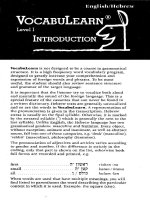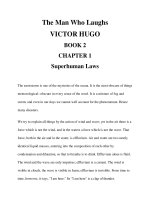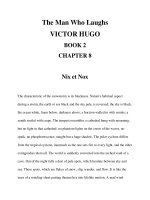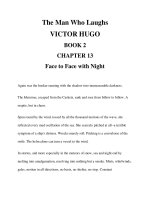Connectivity 1 book
Bạn đang xem bản rút gọn của tài liệu. Xem và tải ngay bản đầy đủ của tài liệu tại đây (8.64 MB, 180 trang )
www.frenglish.ru
www.frenglish.ru
LEVEL 1
CONNECTING PEOPLE THROUGH ENGLISH
Joan Saslow
Allen Ascher
www.frenglish.ru
Connectivity 1
Copyright © 2022 by Pearson Education, Inc.
All rights reserved. No part of this publication may be reproduced, stored in a retrieval system, or transmitted in any form or by any means,
electronic, mechanical, photocopying, recording, or otherwise, without the prior permission of the publisher.
Pearson Education, 221 River Street, Hoboken, NJ 07030 USA
Text composition: EMC Design Ltd
Library of Congress Cataloging-in-Publication Data: A catalog record for the print edition is available from the Library of Congress.
Printed in the United States of America
ISBN-13: 978-0-13-683354-3
ScoutAutomatedPrintCode
pearsonenglish.com/connectivity
www.frenglish.ru
ABOUT THE AUTHORS
Joan Saslow
Joan Saslow is a foreign language teaching specialist and author. She is co-author with Allen Ascher of
a number of award-winning* best-selling English-language textbook series for adults and teenagers,
most recently Pearson’s Top Notch and Summit.
In addition, Ms. Saslow is author of the Workplace Plus, Ready to Go, and Literacy Plus series, as well as of English in Context:
Reading Comprehension for Science and Technology. Earlier, she was series director of True Colors and True Voices.
Ms. Saslow is a frequent speaker at international teachers’ conferences and participates in the English Language Specialist
Program of the US Department of State’s Bureau of Educational and Cultural Affairs. She has lived and taught in Chile and
is fluent in Spanish.
Ms. Saslow has a BA and MA in French from the University of Wisconsin, Madison.
Allen Ascher
Allen Ascher has been an ELT teacher, teacher-trainer, program administrator, consultant, and publisher. He is co-author
with Joan Saslow of the award-winning* six-level Top Notch and Summit series for adults and young adults. He also
authored the “Teaching Speaking” module of Teacher Development Interactive, Pearson’s online multimedia teachertraining program. In addition to living and teaching in Beijing, China, he served as academic director of the International
English Language Institute at Hunter College and taught in the teaching certificate program at the New School in
New York City.
Mr. Ascher has an MA in Applied Linguistics from Ohio University and has been a frequent presenter at professional
conferences and teacher training events around the world.
*Top Notch and Summit are both recipients of the Association of Educational Publishers’ Distinguished Achievement Award.
Additionally, Top Notch third edition is the recipient of a Textbook and Academic Authors’ Textbook Excellence Award.
Summit third edition is the winner of the same award.
AUTHORS’ ACKNOWLEDGMENTS
The authors are indebted to these reviewers, who provided extensive and detailed feedback and suggestions during the
development of Connectivity, as well as the hundreds of teachers who completed surveys and participated in focus groups.
Jorge Aguilar, Centro de Estudio de
Idiomas, Universidad Autónoma de Sinaloa,
Mexico • Manuel Wilson Alvarado Miles,
Quito, Ecuador • Cris Asperti, CEL LEP,
São Paulo, Brazil • Edwin Bello, PROULEX,
Guadalajara, Mexico • Mery Blum, CBA,
Cochabamba, Bolivia • Sandra Vargas
Boecher Prates, Programa Cursos de
Línguas-UFES, Brazil • Pamela Cristina Borja
Baltán, Quito, Ecuador • Jorge Braga, IBEU,
Brazil • Esther María Carbo Morales, Quito,
Ecuador • Jorge Washington Cárdenas Castillo,
Quito, Ecuador • Luis Angel Carrillo, UNID,
Mexico • Angela de Alencar Carvalho Arẳjo,
Colégio Militar de Fortaleza, Fortaleza, CE,
Brazil • Angélica Chávez Escobar, Universidad de
Ln, Mexico • Gemma Crouch, ICPNA Chiclayo,
Peru • Mrs. Elizabeth Cruz Flores, Tecnológico
de Monterrey, Cuernavaca, Mexico • Martin Del
Castillo Palomino, CIVIME Language School, Lima,
Peru • Ingrid Valverde Diaz del Olmo, ICPNA
Cusco, Peru • Edith Espino Inadeh, ITSE,
Panama • María Amparo García, ICPNA Cusco,
Peru • Octavio Gardo Ruiz, IPN Escuela de
Turismo, Mexico • Martha Angelina González
Párraga, Guayaquil, Ecuador • Michael Hood,
Nihon University College of Commerce, Tokyo,
Japan • Zoe Hsu, National Tainan University ,
Taiwan • Segundo Huanambal Díaz, ICPNA
Chiclayo, Peru • Jesse Huang, National
Central University, Taiwan • Sara Iza Pazmiđo,
Universidad Técnica de Ambato, Ecuador • David
Jiménez Huarhua, CIVIME Language School,
Lima, Peru • Eleanor S. Leu, Soochow University,
Taiwan • Yihui Li (Stella Li), Fooyin University,
Taiwan • Chi-Fan Lin, Shih Hsin University,
Taiwan • Linda Lin, Tatung Institute of Tecology,
Taiwan • Patricio David López Logacho, Quito,
Ecuador • Patricia Martins, IBEU, Rio de Janeiro,
Brazil • Patricia McKay, CEL LEP, São Paulo,
Brazil • María Teresa Meléndez Mantilla, ICPNA
Chiclayo, Peru • Maria Helena Meyer, ACEU,
Salvador, Brazil • Johana Melo, Centro Colombo
Americano, Bogotá, Colombia • José Manuel
Mendivil, CBA, La Paz, Bolivia • José de Jesús
Mendoza Rivas, Universidad Tecnológica de
Ln, Mexico • José Minaya Minaya, CIVIME
Language School, Lima, Peru • Hiroko
Miyake, Tokyo Kasei University, Japan • Luis
Fernando Morales Severiche, CBA, Santa Cruz
Bolivia • Andy Morera Calzada, B-able-2
Academy, Quito, Ecuador • Jason Moser,
PhD, Kanto Gakuin University, Japan • Adrián
Esteban Narváez Pacheco, Cuenca,
Ecuador • Mónica Nomberto, ICPNA Chiclayo,
Peru • Jaime Núđez, Universidad Católica de
Honduras, Honduras • Tania Elizabeth Ortega
Santacruz, Cuenca, Ecuador • Juan Camilo
Ortegón, Colombo, Cali , Colombia • Lcdo. Javier
Ortiz, Project Santo Domingo de los Tsachilas
(PUCESD), Ecuador • Joselineth Padrón López,
Charlotte English School, Quito, Ecuador • Martha
Patricia del Carmen Páez, Universidad Politécnica
Salesiana, Quito, Ecuador • Giuseppe Paldino
Mayorga, Jellyfish Learning Center, San Cristóbal,
Ecuador • Luis Antonio Paredes, Universidad
Central de Ecuador, Ecuador • Tarik Preston,
Saudi Arabia • Leni Puppin, Programa Cursos
de Línguas-UFES, Brazil • Allen QuesadaPacheco, Ph.D, University of Costa Rica, San
José, Costa Rica • MA Rocío Isabel Rivera
Cid, Pontificia Universidad Católica de
Valparso, Viđa del Mar, Chile • Luis Rodriguez
Amau, ICPNA Chiclayo, Peru • Llilyan Rodríguez
Conesa, Charlotte English School, Quito,
Ecuador • Amalia Elvira Rodríguez Espinoza De
www.frenglish.ru
Los Monteros, Guayaquil, Ecuador • Rolando
Rodríguez Serra, CIVIME Language School, Lima,
Peru • Melany Rodríguez-Cáceres, Bogotá,
Colombia • Majid Safadaran Mosazadeh,
ICPNA Chiclayo, Peru • Abutarab Saleem,
Hampson English, China • Héctor Sánchez,
PROULEX, Guadalajara, Mexico • Mónica
Alexandra Sánchez Escalante, Quito,
Ecuador • Jorge Mauricio Sánchez Montalvan,
Quito, Ecuador • Cinthia S. Schmiedl Cornejo,
CBA, La Paz, Bolivia • Judith Silva, Universidad
Técnica de Ambato, Ecuador • Anamarija Skoda,
Pontificia Universidad Católica de Valparso,
Santiago de Chile, Chile • Silvia Solares,
CBA, Sucre, Bolivia • María Julia Suárez, CBA,
Cochabamba, Bolivia • Mercedes Tapia Avalos,
CIVIME Language School, Lima, Peru • Prof.
Matthew Taylor, Kinjo Gakuin University, Nagoya,
Japan • Eric Anthony Tejeda Evans, PROULEX,
Guadalajara, Mexico • Blanca Luz Terrazas
Zamora, ICPNA Cusco, Peru • Christian Juan
Torres Medina, Guayaquil, Ecuador • Raquel
Torrico, CBA, Sucre, Bolivia • Ana María de la
Torre Ugarte, ICPNA Chiclayo, Peru • Magdalena
Ullauri, Universidad Nacional del Chimborazo,
Riobamba, Ecuador • Universidad Galileo,
Guatemala City, Guatemala • Juan Omar
Valdez, DR-TESOL, Santo Domingo, Dominican
Republic • Susana Valdivia Marcovich, URP, CIDUP
and Euroidiomas, Lima, Peru • Erika Valdivia de
Souza, CIVIME Language School, Lima, Peru • Jay
Veenstra, Toyo University, Japan • Solange Lopes
Vinagre Costa, SENAC, São Paulo, Brazil • Magno
Alejandro Vivar Hurtado, Universidad Politécnica
Salesiana, Cuenca, Ecuador • Dr. Wen-hsien
Yang, National Kaohsiung Hospitality College,
Kaohsiung, Taiwan • Holger Zamora, ICPNA
Cuzco, Peru
III
LEARNING OBJECTIVES
Connectivity 1 learning objectives are designed for false beginners. They offer a rigorous review and an expansion
of key beginning concepts as well as a wealth of new and challenging material.
Unit
COMMUNICATION GOALS
1
●
●
●
Getting to Know
You
●
VOCABULARY
Introduce and greet people
Get acquainted with
someone
Discuss the importance of
English in your life
Discuss some difficulties of
learning a language
●
Invite someone to an event
Give directions to a place
Talk about musical
preferences
Make plans to see an event
●
Identify people’s abilities
Give advice to someone
who doesn’t feel well
Describe feelings
Discuss how we develop
abilities
●
●
●
Occupations
Personal information
Fields of study for a
career or occupation
2
Events and Places
●
●
●
●
●
Information questions with be: Review
Contractions
Yes / no questions and short answers with be: Review
GRAMMAR EXPANDER
Information questions with be: usage and form (review)
● Possessive nouns and adjectives (review)
● Verb be: usage and form
● Short answers with be: common errors
● Modification with adjectives
●
page 1
●
GRAMMAR
●
●
●
Entertainment events
Directions and locations
Musical genres
●
Abilities
Ailments
Adjectives for feelings
●
Prepositions of time and place: Review
GRAMMAR EXPANDER
● Prepositions of time and place: usage rules
page 13
3
●
●
●
How We Feel
●
●
●
●
●
Can and can’t for ability and possibility
Can and can’t: Information questions
Should and shouldn’t for advice
GRAMMAR EXPANDER
Can + base form for permission
Can and should: common errors
●
●
page 25
4
●
●
●
Talking about
People
●
Respond to good or bad
news
Describe and compare
people
Describe similarities and
differences
Discuss trends in family
households
●
Order from a menu
Discuss ways to prepare
food
Talk about healthy and
unhealthy foods
Describe food habits and
tastes
●
●
●
●
More family relationships
Marital status and
relationships
Adjectives to describe
people
Similarities
●
Parts of a meal
Adjectives for food
preparation
Categories of food
●
page 37
5
●
●
●
Eating in
Restaurants
page 49
IV
●
●
●
●
The simple present tense: Review
Comparative adjectives
GRAMMAR EXPANDER
The simple present tense: usage and form
Spelling rules with he, she, and it (review)
● Comparative adjectives: spelling rules
● Modifying comparative adjectives with much, a lot,
a little (OR a little bit)
●
●
●
●
Count and non-count nouns: Review
Definite article the for specific reference
Some and any; Anything and nothing
GRAMMAR EXPANDER
Making non-count nouns countable (review)
Nouns that can be count or non-count
● Plural nouns: spelling rules
● Non-count nouns: categories
● Questions with How much and How many (review)
●
●
www.frenglish.ru
CONVERSATION STRATEGIES
●
●
●
●
Ask personal questions to indicate
friendliness
Say “Same here” when you have the same
opinion
Ask “What about you?” to ask for reciprocal
information
Respond to what others say with interest
LISTENING / PRONUNCIATION
READING
WRITING / SOFT SKILL
Listening Skills
● Listen for details
Texts
● A language school website
● An illustrated conversation
● A personal information form
● A survey about English use
● An article about accents
Task
● Write a short description of
a classmate
Skills / Strategies
Confirm content
● Understand from context
●
Texts
A survey about entertainment events
● An illustrated conversation
● An article about the benefits of music
● A survey about musical tastes and
preferences
● An entertainment events page
Task
● Write about your tastes in
entertainment
Pronunciation
● Intonation of questions
●
●
●
●
●
●
●
●
●
●
●
●
Use “Let’s” to propose a joint plan of action
Provide a reason to decline an invitation
Express disappointment with “Too bad”
Politely get someone’s attention with
“Excuse me”
Repeat a question with rising intonation to
confirm understanding
Say “Thanks a lot” to acknowledge
someone’s help
Say “Thanks, anyway” to acknowledge an
unsuccessful attempt to help
Listening Skills
● Listen for key
information
● Listen for errors
Say “Sure. What’s up?” to respond to a
request for help
Introduce a request with “Well”
Acknowledge a favor with “I owe you one”
Say “Feel better!” to someone who is sick
Listening Skills
● Listen for main ideas
● Listen for details
● Listen for key
information
Pronunciation
● Rising intonation to
confirm understanding
●
Texts
A personal abilities self-test
An illustrated conversation
● An advice website
● A feelings self-test
●
●
Skills / Strategies
Confirm content
● Understand details
Pronunciation
● Can / can’t
●
●
●
●
Indicate you’re happy to hear someone’s
good news
Indicate you’re unhappy to hear someone’s
bad news
Acknowledge gratitude for someone’s
interest with “Thanks for asking”
Say “Let me think” to give yourself time to
think of an answer
Use “Well” to introduce a description
Listening Skills
● Listen for main ideas
● Listen for details
● Listen to classify
● Listen to confirm
content
●
●
●
●
Use “please” at the end of statements when
ordering food in a restaurant
Use “I’d like” and “I’ll have” to order food
from a server
Use “Certainly” to agree to a customer’s
request
Agree with a positive opinion with “Me too”
Agree with a negative opinion with “Me
neither”
Texts
Descriptions of family relationships
An illustrated conversation
● An article about two sets of twins
● A survey about typical households
●
●
Skills / Strategies
Classify
● Identify similarities
Pronunciation
● The
SOFT SKILLS BOOSTER
Enthusiasm: Use verbal
cues to show that you’re
paying attention
Task
● Write a conversation
between two people:
a school advisor and a
student OR two colleagues
WRITING HANDBOOK
Punctuation of statements
and questions
●
SOFT SKILLS BOOSTER
Conflict resolution: Politely
introduce a different
opinion
●
Listening Skills
● Listen to infer
● Listen for details
● Understand from
context
WRITING HANDBOOK
The sentence
●
●
Pronunciation
● Linking sounds
●
SOFT SKILLS BOOSTER
Respect: Demonstrate
respect for what other
people say
●
Skills / Strategies
● Scan for facts
● Make personal connections
●
●
WRITING HANDBOOK
Capitalization
●
Task
● Write a description of the
similarities and differences
between two people in
your extended family
WRITING HANDBOOK
Combining sentences with
and or but
●
SOFT SKILLS BOOSTER
Open-mindedness: Offer
a new perspective on an
issue
●
Texts
A restaurant website
An illustrated conversation
● A restaurant menu
● A survey about foods
● An article about street food
● A questionnaire about street food
Task
● Write about eating out in
your country
Skills / Strategies
Confirm content
●
●
●
●
www.frenglish.ru
WRITING HANDBOOK
Connecting words or
ideas: and and in addition
●
SOFT SKILLS BOOSTER
Creativity: Generate many
ideas in response to an
open-ended prompt
V
Unit
COMMUNICATION GOALS
6
●
●
●
Living with
Technology
●
VOCABULARY
Describe advantages and
disadvantages of a brand
Talk about things that
aren’t working
Describe smart phone
habits
Discuss the challenges of
traveling with technology
●
●
●
●
●
page 61
●
7
●
●
●
Vacations and
Travel
●
Greet someone arriving
from a trip
Report a change in travel
plans
Describe good and bad
vacations
Discuss some hassles of
travel
page 73
8
●
●
●
●
●
●
●
●
●
Shopping for
Clothes
●
●
Shop and pay for clothes
Ask for a recommendation
for a place to shop
Give directions within
buildings
Describe local clothing
customs
●
Make a date to get
together
Suggest how to get in
shape
Discuss recreation
equipment
Describe accidents and
injuries
●
●
●
●
GRAMMAR
Devices
Household appliances
and devices
Positive and negative
descriptions
Collocations for using
technology
Some smart phone
activities
Powering electronic
devices
●
Activities
Adjectives to describe
trips
Intensifiers
Kinds of tickets and seats
Past time expressions
Years, decades, and
centuries
Airport information
●
Clothing items
Types of clothing and
accessories
Interior locations and
directions
Adjectives for describing
clothing customs
●
Exercise activities
Places for sports, games,
and other exercise
Land and water
recreation activities
Collocations with go
Recreation equipment
Parts of the body
Accidents and injuries
●
Wishes for the future
Organizing a business or
social event
Job benefits
●
●
The present continuous: Review
The present continuous and the simple present tense:
Review
GRAMMAR EXPANDER
The present continuous: spelling rules for the present
participle
● The present continuous: rules for forming statements
and questions
● The simple present tense: non-action verbs
● The simple present tense: placement of frequency
adverbs
● Time expressions
●
●
●
The past tense of be
The simple past tense: Statements
The simple past tense: Questions
GRAMMAR EXPANDER
The past tense of be: form
The simple past tense: more about usage and form
● Spelling rules for regular verbs
●
●
●
Object pronouns: Usage
Superlative adjectives
GRAMMAR EXPANDER
Direct and indirect objects
Superlative adjectives: spelling rules
● Comparatives and superlatives (review)
●
●
page 85
9
●
●
●
Fitness and
Health
●
page 97
10
●
●
●
●
●
●
●
●
Life Goals and
Plans
●
●
Express wishes for the
future
Plan a business or social
event
Describe ways to make a
dream come true
Discuss what makes a job
attractive
●
●
●
●
Have to / has to
Modals should and could
GRAMMAR EXPANDER
Have to / has to: form and common errors
Have to / has to: information questions
● Should and could: information questions
● Modals: common errors
● Can and be able to: present and past forms
●
●
●
Would like + an infinitive
Be going to + base form
GRAMMAR EXPANDER
Other ways to express future wishes
Would love / would prefer / would hate + infinitive
● Other ways to express the future
●
●
page 109
VI
www.frenglish.ru
CONVERSATION STRATEGIES
●
●
●
●
●
●
●
Greet someone informally with “Hey”
Indicate understanding with “Oh”
Express gratitude with “I appreciate it”
Respond to a thank-you with “Anytime”
Respond emphatically with “You bet”
Express surprise with “What do you mean?”
Sympathize with another person’s problem
LISTENING / PRONUNCIATION
READING
WRITING / SOFT SKILL
Listening Skills
● Listen to infer
● Listen for details
Texts
● A survey about electronic devices
● An illustrated conversation
● An article about smart phone
addiction
● A survey about smart phone habits
Task
● Write about an electronic
device that is important to
you
Skills / Strategies
Activate language from a text
Interpret an infographic
● Understand from context
●
Pronunciation
● Intonation of questions
●
●
●
●
●
●
●
●
●
●
●
●
●
●
●
●
●
●
●
●
●
●
●
●
Welcome someone home who has been
away for a while
Use “So” to initiate small talk
Offer assistance with “Can I give you a
hand?”
Decline help with “It’s OK. I’m fine.”
Identify yourself on the phone with “It’s” or
“This is”
Express sympathy with “Oh, no”
Express relief with “Thank goodness”
Agree strongly with “You can say that
again”
Listening Skills
● Listen for main ideas
● Listen for details
Begin an interaction with a salesperson
with “Excuse me”
Start a new topic with “By the way”
Respond helpfully with “Certainly” or “Of
course”
Acknowledge someone’s assistance with
“Thanks for your help”
Say “That depends” when an answer might
be complicated
Ask for more information with “What
about . . .?”
Listening Skills
● Listen for key
information
Say “Why don’t we . . . ?” to make an
invitation
Accept an invitation with “I’d love to”
Propose a tentative time or place as a
question
Propose an option with “How about . . . ?”
Use “To tell you the truth” to soften a
statement of disagreement
Use “So” to introduce a conversation topic
Say “What do you mean?” to request
clarification
Politely request a favor with “Could you
possibly . . . ?”
Respond willingly to a request with “I’d love
to” or “I’d be happy to”
Assure someone that everything is OK with
“No worries”
Pronunciation
● The three simple past
tense endings for
regular verbs
●
Texts
A vacation activities preference test
An illustrated conversation
● A passenger boarding pass
● A magazine travel column
●
●
Skills / Strategies
● Understand from context
● Draw conclusions
Texts
A questionnaire about clothing
preferences
● An illustrated conversation
● An article about planning for a
business trip
● A questionnaire about personal
dress codes
●
Pronunciation
Contrastive stress for
clarification
●
Listening Skills
● Listen for main ideas
● Listen for details
●
●
Skills / Strategies
Identify the main idea
Understand from context
● Apply ideas
●
Task
● Write about a vacation you
took
WRITING HANDBOOK
Time order
●
SOFT SKILLS BOOSTER
Willingness to learn more:
Confirm understanding of
what someone said
●
Task
● Write an explanation for
visitors to your country of
the do’s and don’ts for
appropriate dress
WRITING HANDBOOK
Connecting ideas with
because and since
●
SOFT SKILLS BOOSTER
Intercultural competence:
Demonstrate your
awareness that cultures
differ
●
Task
● Write about the outdoor
activities you like and don’t
like
Skills / Strategies
Scan for facts
●
●
Pronunciation
● Be going to + base
form
SOFT SKILLS BOOSTER
Empathy: Share common
experiences
●
Texts
A brochure for a popular health club
An illustrated conversation
● An article about physical therapy
●
Pronunciation
● Sound reduction of to in
have to / has to
Listening Skills
● Listen to confirm
content
● Listen for details
● Make personal
connections
WRITING HANDBOOK
Placement of adjectives:
before nouns and after the
verb be
●
WRITING HANDBOOK
The paragraph
SOFT SKILLS BOOSTER
Empathy: Show others
that you care about their
hardships
●
Texts
A self-test about what makes people
successful
● An illustrated conversation
● An article about life dreams
● Descriptions of employment
situations
●
Skills / Strategies
Understand from context
● Infer a point of view
●
Reference Charts
page 124
Grammar Expander
page 126
Writing Handbook
page 145
Soft Skills Booster
page 154
www.frenglish.ru
Task
● Write about your idea of a
perfect job
WRITING HANDBOOK
Connecting contradictory
ideas
●
SOFT SKILLS BOOSTER
Optimism: Offer
encouragement to others
●
VII
COMPONENTS
For the Teacher
Connectivity makes lesson preparation easier with a wide array of time-saving tools for
presentation and planning all in one place.
Presentation Tool
A digital tool for presenting the content of
the Student’s Book (and optional Workbook)
in class, accessible through the Pearson
English Portal.
Allows you to:
• navigate easily between units, lessons, and
activities.
• pop up all activities from the page, for
display and to show answers.
• play all the audio files from the page.
• present all the Connectivity videos, including
Keep Talking, the Grammar Coach, the
Pronunciation Coach, and the hilarious
Connect TV sitcom.
The Presentation Tool is also available to
download, enabling you to teach offline.
Teacher’s Book and Lesson Planner
Detailed interleaved lesson plans, language and culture notes, optional activities, and more.
Available in print and as a pdf in the Teacher’s Resources on the Portal.
• Ideas for extension activities, differentiated instruction, teaching tips, alternative ways to do activities,
advice on dealing with tricky language items, and notes on how to remediate and motivate students.
• Annotated answers on the facing Student’s Book pages.
Teacher’s Resources
Comprehensive, easy-to-access resources for
planning, teaching, and professional development.
Includes:
• a wide choice of downloadable worksheets to
enhance and extend each lesson.
• a dedicated Connectivity Methods Handbook
which highlights Connectivity’s course pedagogy
and presents best practices for teaching a
communicative course.
• Teaching with Connectivity videos, for overview,
planning, and teacher support.
• answer keys and audio/video scripts.
• Global Scale of English mapping booklets, for
efficient planning.
• ready-made achievement tests, with a test generator.
VIII
www.frenglish.ru
For the Student
A code gives students access to the digital components: the Student’s Interactive eBook,
Online Practice, and a student’s app. A separate print Workbook is also available.
Student’s Interactive eBook
Student’s Book in digital format.
The eBook enables students to access their Student’s
Book materials on their computer and mobile devices,
wherever and whenever they want. The digital format
enhances student engagement with interactive
activities, and audio and video at the point of use.
Student’s App
Digital practice that empowers students to take charge of
their learning outside of class, online and offline.
It gives students access anytime, anywhere to the complete
Connectivity audio and video program as well as hundreds of
activities for grammar, vocabulary, pronunciation, listening
comprehension, and speaking practice. Connectivity app
content is available on the Pearson Practice English App.
Online Practice
Lesson-by-lesson exercises to accompany the Student’s
Book with an abundance of interactive practice
activities in all skills.
Offers:
• immediate feedback on wrong answers.
• a listen-and-record feature that allows students to
compare their pronunciation to a model.
• extra reading and writing practice.
• a gradebook that allows you to monitor progress and
plan future practice.
Workbook
Lesson-by-lesson written practice activities to accompany the Student’s Book, providing
extra practice for vocabulary, grammar, conversation, social language, reading, and writing.
Offers:
• open-ended, personalized activities to increase student engagement.
• full-color design with numerous illustrations and photos.
• additional exercises for Grammar Expander and Writing Handbook.
www.frenglish.ru
IX
KEY TO ICONS IN THE STUDENT’S BOOK
Digital resources are available on the Pearson English Portal (the access code is provided on the inside front cover).
Audio and video are also available in the Student’s Interactive eBook and Pearson Practice English App.
CORE MATERIAL
Student’s Book icon
What is it?
Student’s Book audio
Coach videos that extend the content of the Grammar and
Pronunciation presentations in each Student’s Book unit
COACH
KEEP TALKING!
Keep Talking videos that provide a dramatized model of how
students can expand their Conversation Pair Work
Watch the video for ideas!
SUPPLEMENTAL MATERIAL
Student’s Book icon
What is it?
An abundance of digital resources comes with every
Connectivity Student’s Book:
FOR MORE PRACTICE, GO TO YOUR DIGITAL RESOURCES
• Pearson Practice English App: A mobile app that provides
additional language practice activities, and gives students
quick access to course audio and video
• Online Practice: Additional practice activities tied to a
gradebook (these activities are different from the ones
included on the app)
For more
practice . . .
X
End-of-unit review and extension material offered in several
formats:
• Unit Review: Printable exercises for extra listening
comprehension and language practice
• Connect TV: A hilarious sitcom for language consolidation
and fun
• Test-Taking Skills Booster: Practice for skills typically included
in standardized proficiency tests
www.frenglish.ru
TO THE TEACHER
Connectivity is a six-level course for adults and young adults who need to use English fluently and confidently
in their life and work, and to interact with people from a variety of language backgrounds and cultures.
Ideal for students who lack opportunities to observe or practice English outside of class, Connectivity creates
a highly enriched blended language learning experience by ensuring:
• repeated exposure to natural authentic spoken and written language models.
• thorough coverage of form, meaning, and use.
• dynamic integration, recycling, and activation of new language.
• ongoing confirmation of progress and self-assessment.
With two alternative entry points—Connectivity Foundations for true beginners and Connectivity 1 for false
beginners—the course is benchmarked to the Global Scale of English and tightly correlated to the Can-do
Statements of the Common European Framework of Reference. All six levels are available in full and split formats.
Each full level of Connectivity provides 60–90 hours of instruction and is designed for use in traditional, hybrid,
flipped, and blended settings. An unequaled array of printable, digital, and online resources makes it easy to vary
and tailor the course to your teaching style, your learners’ needs, your available time, or even to extend the hours
of instruction to up to 120 hours.
SIGNATURE FEATURES
A Systematic Speaking Pedagogy
Individualized Teaching and Learning
Connectivity rigorously develops learners’ linguistic,
socio-linguistic, and pragmatic competence and fluency.
Socially authentic model conversations systematically
encourage improvisation and extension, and discussion
preparation activities recycle language and build
confidence. Soft skills practice—woven throughout—
prepares learners for employability in English. Mediation
activities ensure students can use English to interact with
people from diverse language and culture groups and
are able to react to, summarize, and paraphrase spoken
and written texts in English. Additionally, an optional Soft
Skills Booster (Levels 1–3) provides applied language
practice of selected skills.
Respecting teachers’ individual styles and preferences,
as well as their limited time to prepare material,
Connectivity offers over a thousand extra ready-to-use
printable extension activities so that teachers never have
to search for or create supplements. A wide choice of
extra speaking activities, unit reviews, supplementary
pronunciation activities, inductive grammar charts,
unit study guides, writing process worksheets, video
worksheets, flash cards, extra grammar exercises, testtaking skill builders, and more are available for every unit.
Explicit Grammar and Vocabulary
Connectivity takes the guesswork out of form, meaning,
and use. Clear charts illustrate grammar and usage
in context and Notice the Grammar activities increase
learners’ grammar awareness. Pronounce the Grammar
activities promote spoken mastery. Clear captioned
picture-dictionary-style vocabulary illustrations with
accompanying audio ensure understanding and
accurate pronunciation of new words. Interactive digital
vocabulary flash cards provide continual practice and
recycling for memorability.
A Multi-faceted Audio and Video Program
Connectivity includes a wealth of audio and video features
for the modeling of authentic speech, conversation
pair work activation, listening comprehension practice,
pronunciation practice, and fun. So that students will
be prepared to understand English as an international
language, the audio includes a variety of native and nonnative accents. Connectivity’s listening comprehension
syllabus builds key skills and strategies to improve listening
proficiency. Practi-chants (Foundations) develop fluency
and confidence with the support of a fun and engaging
beat. A video Pronunciation Coach and a Grammar
Coach provide additional guidance. The Keep Talking
video increases oral production and fluency. Finally,
Connect TV, a hilarious situation comedy, keeps students
laughing and learning.
We hope that Connectivity maximizes your enjoyment and success!
We wrote it for you.
Joan Saslow and Allen Ascher
www.frenglish.ru
XI
www.frenglish.ru
UNIT
1
Getting to Know You
I want to meet people from a lot of
countries. I need English for that!
Warm-Up
Why are you studying English? You can check ✓ more than one reason!
I want to communicate with people
who don’t speak my language.
I want to travel internationally.
I want to study in another country.
I want to use English in my work.
For a different reason:
UNIT 1
COMMUNICATION
GOALS
Lesson 1
Lesson 2
Lesson 3
Lesson 4
Introduce and
greet people
Get acquainted
with someone
Discuss the importance
of English in your life
Discuss some difficulties of
learning a language
www.frenglish.ru
UNIT 1
1
Topic Warm-Up
A
WHY STUDY ENGLISH? | Read the information on the language school website. Add a comment.
HOME
ENGLISH!
LEARNING CENTERS!
ENGLISH COURSES
ABOUT US
LOCATIONS
CONTACT US
Why study English?
Here are five popular reasons.
It’s the international language
of science and technology.
It’s the international language of business.
It makes it easy to get
information on the Internet.
It’s a language of popular
culture (movies, TV, music).
It’s useful for communicating
with visitors to my country.
Login
Read comments from our students. Add a comment of your own!
Samtheman
March 3 at 7:55 A .M.
A lot of my favorite websites are in English.
Friendly Frida
March 4 at 2:25 P.M.
I love American movies! I like the actors’ accents.
Add your own comment:
B
2
SURVEY | How many students in your class are studying English for . . .
work?
the Internet?
travel?
movies, TV, or music?
study in another country?
another reason?
UNIT 1
www.frenglish.ru
Language Warm-Up
UNDERSTAND A VARIETY OF ACCENTS
A
ZOOMIN | Read and listen to tourists getting
acquainted before a tour. Notice the featured
words and phrases.
Marty: Excuse me. Are you on the
nine o’clock tour?
Jin-soo: Yes, we are. You too?
Marty: We are. By the way, I’m Marty
Teller. And this is my wife, Ana . . .
and our daughter, Catherine.
Jin-soo: And I’m Jin-soo Park. Nice
to meet you, Mr. and Mrs. Teller . . .
Catherine.
B
Marty = American English (standard)
Ana = Spanish
Jin-soo = Korean
Sunny = Korean
Catherine = American English (standard) Guy = French
Marty: It’s a pleasure to meet you,
too. But please call me Marty.
Catherine: And everyone calls me
Cat. It’s my nickname.
Jin-soo: OK, then, Cat! And let me
introduce you all to my wife, Sunny.
Ana: So where are you from?
Sunny: We’re from Seoul, South Korea.
And you?
Ana: Well, I’m originally from Ecuador,
but Marty’s from the States. We live
in Dallas.
Guy: Good morning, everyone.
I’m Guy from Paris City Tours.
Does everyone here speak English?
Sunny: Yes, we do.
Guy: Well, that’s great! The bus is
right outside.
UNDERSTAND FROM CONTEXT | Reread the conversation. With a partner, find:
1 a way to start a conversation with people you don’t know.
2 two polite things to say to someone when you first meet.
3 two ways to introduce someone.
4 two ways to invite someone to address you informally.
SPEAKING GROUP WORK | Read Sunny’s information form. Complete the
other one with your information. Use the information to
introduce yourself to your classmates.
Hi, I’m Arturo Casas.
I’m high-beginner level.
ENGLISH!
LEARNING CENTERS!
Personal information
Last / Family Name
Park
First / Given Name
Mi-sun
PERSONAL INFORMATION
Your school’s name:
Last / Family Name
First / Given Name
Nickname (optional)
Sunny
Nationality
South Korean
Nickname (optional)
Occupation
Bank manager
Present English language level (check one)
Beginner
High Beginner
Intermediate
Advanced
Nationality
Occupation
Present English language level (check one)
Beginner
High Beginner
Intermediate
Advanced
www.frenglish.ru
UNIT 1
3
1
A
COMMUNICATION
GOAL
Introduce and greet people
VOCABULARY | Occupations | Read and listen. Then listen again and repeat.
an accountant
a teller
a mechanic
a nurse
a lawyer
a salesperson
a secretary /
an administrative assistant
a tour guide
an electrician
an architect
B
LISTEN TO ACTIVATE VOCABULARY | Listen to people and complete the statements.
Circle the correct occupations.
1 She’s (a tour guide / an architect).
5 She’s (an electrician / a teller).
2 He’s (a bank manager / an administrative assistant).
6 He’s (a nurse / a mechanic).
3 He’s (a nurse / an accountant).
7 She’s (an architect / a teller).
4 He’s (a lawyer / a tour guide).
8 She’s (a nurse / a salesperson).
C
GRAMMAR | Information questions with be: Review
COACH
COACH
D
4
What’s her email address?
What are your names?
Where’s Sam from?
What city are you from?
When’s your birthday?
What time’s the movie?
Who’s your teacher?
Who’s that?
Who are they?
(It’s )
(Alison and Jack.)
(He’s from Seoul, South Korea.)
(I’m from Montevideo.)
(It’s March 22nd.)
(It’s at 5:35.)
(George Baker.)
(That’s my friend Tony.)
(They’re my classmates.)
How’s the weather today?
How old is Melanie?
(It’s hot and sunny.)
(She’s eleven.)
Contractions
What’s = What is
Where’s = Where is
When’s = When is
Who’s = Who is
How’s = How is
I’m = I am
GRAMMAR EXPANDER
p. 126
Information questions with be:
usage and form (review)
● Possessive nouns and
adjectives (review)
●
PRONOUNCE THE GRAMMAR | Listen and repeat the grammar examples.
UNIT 1
he’s = he is
she’s = she is
it’s = it is
you’re = you are
we’re = we are
they’re = they are
www.frenglish.ru
E
GRAMMAR PRACTICE | Complete the conversations. Use contractions of the verb be when possible.
so young!
he?
3 A:
your sister’s occupation?
about
a lawyer.
B: I’m not sure. I think he
B:
twenty-five.
her office?
A: Really?
his name?
A:
B:
on Center Street.
B: It
Franklin Blake. But everyone just
the movie?
4 A: Hey, Ellen.
calls him Frank.
at 6:30. Do you want to go?
B:
that woman over there?
2 A:
A:
not sure. Let’s talk later.
my colleague Fareesa.
B: Oh, that
B: OK. How about at 2:30?
A:
she from?
your number?
A: Perfect.
B:
from Pakistan.
B:
555-4377.
1 A: Your teacher
F
PAIR WORK | Now practice the conversations from Exercise E.
G
GRAMMAR PRACTICE | On a separate piece of paper, write four information
questions with be for a partner.
H
PAIR WORK | Ask your partner your questions from Exercise G.
COMMUNICATION
ACTIVATOR
Ideas
Who . . . ?
What . . . ?
Where . . . ?
How old . . . ?
Now let’s introduce and greet people.
CONVERSATION MODEL | Read and listen.
A
A:
B:
A:
B:
C:
B:
Let me introduce you to Mark.
OK!
Lisa, I’d like you to meet Mark. Mark, Lisa.
Pleasure to meet you, Mark!
Same here! So where are you from?
I’m from Atlanta.
What about you?
Social language
C: I’m from New York.
Say “Same here” when you
B: And what do you do?
have the same opinion.
C: I’m a photographer.
B
PRONUNCIATION PRACTICE | Listen again and repeat.
Then practice the Conversation Model with two partners.
C
CONVERSATION GROUP WORK | With two classmates, personalize
the conversation, using real names and information. Then change roles.
.
A: Let me introduce you to
!
B:
KEEP TALKING!
, I’d like you to meet
.
,
.
A:
B:
C:
B:
C:
B:
C:
D
to meet you,
!
Same here! So where are you from?
I’m
. What about you?
I’m
.
And what do you do?
I’m
.
Ask more questions and provide
more information.
What’s your last name?
What’s your [email address]?
Watch the video for ideas!
CHANGE PARTNERS | Personalize the conversation again. Introduce other people.
FOR MORE PRACTICE, GO TO YOUR DIGITAL RESOURCES
www.frenglish.ru
UNIT 1
5
2
COMMUNICATION
Get acquainted with someone
GOAL
VOCABULARY | Personal information | Read and listen. Then listen again and repeat.
A
1
“I’m originally from Egypt,
but my nationality is Canadian.
I’m a Canadian citizen, and I
have a Canadian passport.”
B
C
3
“My birthplace is Cairo,
but I don’t live there now.”
“I live in Toronto. That’s
my hometown now.”
4
5
“I speak English and French,
but my native language
(or first language) is Arabic.”
“My marital status?
I’m married. I’m not single.”
PAIR WORK | Get acquainted with a classmate. Ask him or her questions.
Answer your partner’s questions. Use all the vocabulary.
What’s your birthplace?
COACH
2
My birthplace? It’s Taipei.
Titles
For men:
Mr. = married
or single
For women:
Ms. = married
or single
Mrs. = married
Miss = single
Use titles with family names,
not given names.
GRAMMAR | Yes / no questions and short answers with be: Review
Are you married?
Is she Chinese?
Is your birthplace São Paulo?
Are you and your brother single?
Are they from Chicago?
Yes, I am.
Yes, she is.
Yes, it is.
Yes, we are.
Yes, they are.
No, I’m not.
No, she’s not. [No, she isn’t.]
No, it’s not. [No, it isn’t.]
No, we’re not. [No, we aren’t.]
No, they’re not. [No, they aren’t.]
Be careful!
Yes, I am. NOT Yes, I’m.
Yes, she is. NOT Yes, she’s.
GRAMMAR EXPANDER
●
D
E
PRONOUNCE THE GRAMMAR | Listen and repeat the
grammar examples.
GRAMMAR PRACTICE | Complete the conversations. Use contractions when possible.
your nationality Brazilian?
3 A:
your first language English?
.
B: Yes,
B: No,
. It’s Swedish.
1 A:
2 A:
B: No,
6
UNIT 1
they single?
. They’re married.
4 A:
B: No,
www.frenglish.ru
p. 127
Verb be: usage and form
Short answers with be: common
errors
● Modification with adjectives
●
that man’s name Bart?
not. It’s Ken.









